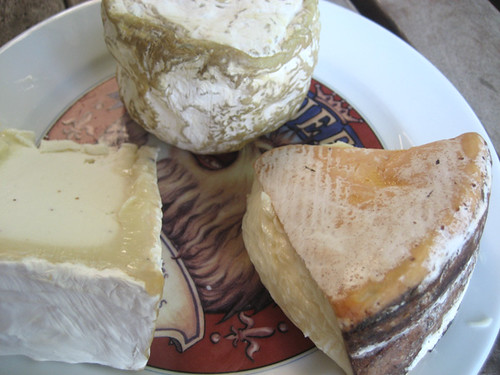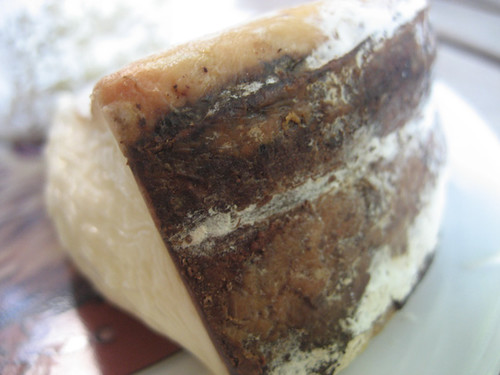First in a new feature in which we eat cheese, and blog cheese.
I’ve decided I need to get more serious about cheese. By which I mean, there’s this cheese scene in America, and I basically only buy cheese by type— hard, soft, goat. Put them in front of me and mmmnnnummmnmm, I eat, but I don’t analyze. I don’t remember what I liked, and why. I need to take cheese more seriously and thoughtfully. Hence this new feature, in which I’ll write about specific new cheeses in our fabulous cheesy era of great cheese.
But first: radishes. I went to look at my Earthboxes the other day, and wow, French breakfast radishes were practically forcing themselves out of the ground, like mandrakes getting ready for a good scream. I don’t think the miracle of growing had ever been quite so forcefully impressed upon me— a couple of weeks ago, mud, that has somehow been turned into this bright pink and white thing. I think it’s the color that really struck me. I’m used to green coming out of the ground, but this was like something made of bright plastic had grown there. It was like I was harvesting Christmas ornaments, or Barbies.

Anyway, I plucked some out of the ground and washed them, to slice and serve on rye bread (Lithuanian rye, Today’s Temptations) with some goat butter, in imitation of how they are served at The Bristol. And then I unwrapped my three new cheeses from Whole Foods. They were:

At the top, a raw milk cheese, Constant Bliss from Jasper Hill in Greensboro, Vermont. I love their description of it:
Constant Bliss is based on a Chaource recipe, which we modified to suit our production schedule and cheesemaking facility. The result is a cheese which hardly even resembles a Chaource. It is a slow ripened lactic curd made only with fresh, right out of the cow, uncooled, evening milk. We actually begin the cheesemaking process before the cows have finished milking… It is aged 60 days before it leaves the farm, and is a ‘sell it or smell it’ item for retailers… We named Constant Bliss after a revolutionary war scout killed in Greensboro by native Americans in 1781.
Because nothing says cheese like death by tomahawk. At right, with the orange rind, is another Jasper Hill raw milk cheese, Winnemere (or is it Winnimere? There seems to be no consensus online), made seasonally (the season just ended, actually) and washed with raspberry lambic beer and wrapped in spruce bark. At left is Truffle Tremor, a soft and creamy goat cheese with bits of black truffle in it, from the well-known goat cheesemaker Cypress Grove in Arcata, California.
Let’s start with the latter. Truffle is an easy flavor to use to dress up foods, or to overdress them, and it’s often synthetic, so it’s nice that the truffle here is both subtle and seems complex and multidimensional—in a word, real. I don’t think this is a brilliantly made cheese, but it’s certainly a good one, and high quality as flavored cheeses go.
Constant Bliss instantly seems to have greater depths, to have more going on. The simple gooeyness of the camembert-like texture begins to develop, like a Polaroid, into an almost tomatoey ripeness. It’s a strong cheese, not in the stinky sense, but just in that it refuses to go away for a while, hanging around on the tongue showing attitude.
Finally, Winnemere, with its splendidly diseased-looking rind:

You taste little fruity hints of the lambic and the spruce at first. The creaminess settles in on your tongue for a long night of watching B.J. and the Bear reruns on MeTV, when suddenly you smell—hey, is that vanilla? Who vanillaed in here? And you’re looking at Winnemere and it’s going what, I don’t smell vanilla and you’re saying dude, you’re totally vanillaing in my mouth.
Winnimere seems to have attracted a lot of excitement in the cheese world, as most things only available half the year do, and rightly so. It’ll probably be gone in a few weeks, so grab it now and be prepared for it to do whatever it wants to in your mouth.


 If you like this post and would like to receive updates from this blog, please subscribe our feed.
If you like this post and would like to receive updates from this blog, please subscribe our feed.




